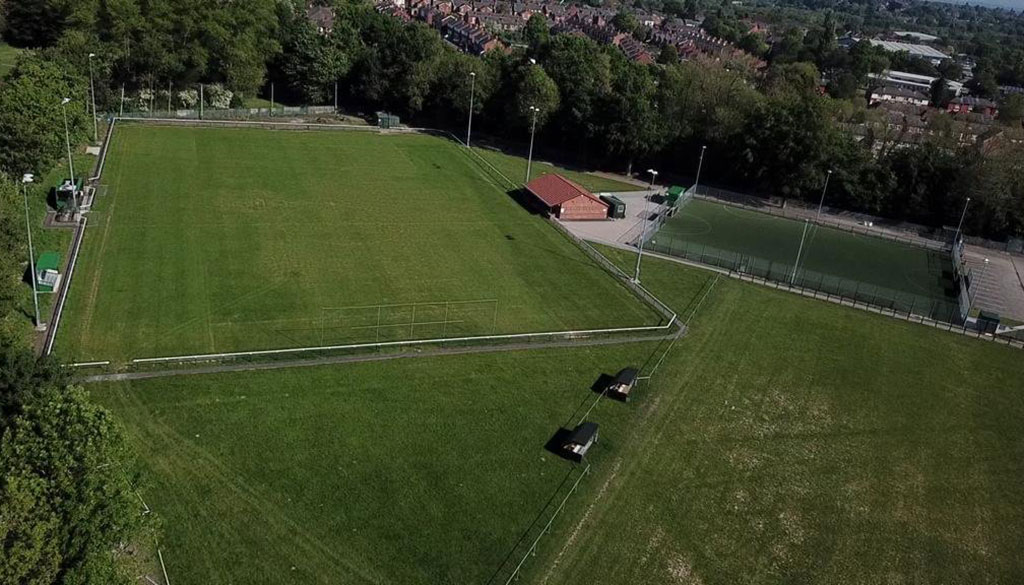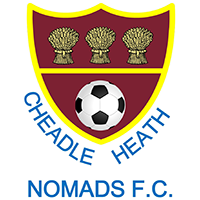
Emblematically Speaking - Cheadle Heath Nomads
Tue 15th January 2019 | Cheadle Heath Nomads | By Stewart Taylor
This week we get to explore in detail one (or even three) of the most recognisable devices representing one part of the geographical footprint of the Hallmark Security League, namely, the wheatsheaves of Cheshire.
But before we do that, we can put the real subject of this week’s article, namely the emblem of Cheadle Heath Nomads FC, into context.
Club director Roy Welsh takes up the story.
“The club did not have a badge until the 1970's when Roy Welsh and Micky Chadderton (a player at the time whose grandfather had played for the club in the early 20's) decided a badge was needed.
"Some attempts were made to find a local coat of arms without too much success, although there were some found with no real identity. The common feature was the incorporation of wheatsheaves surrounded by lions rampant etc.
"Roy and Micky set about designing something incorporating what they knew, but at that time the embroidery of lions etc. was not easy and very expensive. The animals were dropped in favour of three wheatsheaves and a ball!
"Club members and players approved, and the badge has been essentially the same ever since”.
As we might expect, the colourways represent the playing colours of the club and a quick glance at the emblem tells the observer pretty much all they need to know about the purpose of the organisation.
The reference to the lions is of interest in that they do indeed appear regularly in the heraldry of Cheshire and, with improving technology, it would probably have been less cost prohibitive now than in the 1970s to embroider such lions.
But decisions are made for all of the right reasons at the time and the emblem, without lions, fulfils its purpose admirably.
The link with royalty, hence the lions, is clear in that back in the day the title of Earl of Chester was bestowed upon heirs apparent to the throne of England.
The last of these was Edward Plantagenet, Earl of Chester, who became King Edward III in 1327. From that time to the present day, the heir apparent to the throne has been given the title of the Prince of Wales but is also the Earl of Chester
Regular readers of these articles will have seen several references to the wheatsheaves, known heraldically as garbs, representing the County of Cheshire but may well have wondered about how this came about.
We can trace their history in the heraldry of Cheshire way back to Medieval times. Here we find Hugh de Kavelioc, 5th Earl of Chester (1147 – 1181) using six wheatsheaves but that was later reduced to the now very traditional three by his son, and, hence, the 6th Earl of Chester, Ranulf de Blondville (1170 – 1232).
Moving on in time and we see the incorporation of the Cheshire Coat of Arms which dates from as far back as 1580.
In this we see the lions, referred to above by Roy, and the wheatsheaves. Heraldic scholars ascribe the lions as being representative of royalty, as above, and the wheatsheaves of agriculture.
Quite why the reduction from six to three is unclear but such was the dominance of agriculture in the county of Cheshire many years ago it is likely that wheatsheaves were to signify plenty – a good harvest perhaps?
Not for the first time in this series of short articles, we can find in a football club emblem the inspiration to follow a certain path of research, in this case wheatsheaves, which can lead to a better understanding of local history.
Before we finish this week’s offering it would be remiss of me not to make reference to our old friend the River Mersey, and the various signs on roads across the mighty river which have signs showing three wheatsheaves to welcome travellers to the county of Cheshire – land of plenty and county of my birth!
With grateful thanks to Roy Welsh of Cheadle Heath Nomads for his invaluable contribution to this article.
 Emblematically Speaking - Cheadle Heath Nomads
Emblematically Speaking - Cheadle Heath Nomads
Tue 15th January 2019 | Cheadle Heath Nomads
By Stewart Taylor

This week we get to explore in detail one (or even three) of the most recognisable devices representing one part of the geographical footprint of the Hallmark Security League, namely, the wheatsheaves of Cheshire.
But before we do that, we can put the real subject of this week’s article, namely the emblem of Cheadle Heath Nomads FC, into context.
Club director Roy Welsh takes up the story.
“The club did not have a badge until the 1970's when Roy Welsh and Micky Chadderton (a player at the time whose grandfather had played for the club in the early 20's) decided a badge was needed.
"Some attempts were made to find a local coat of arms without too much success, although there were some found with no real identity. The common feature was the incorporation of wheatsheaves surrounded by lions rampant etc.
"Roy and Micky set about designing something incorporating what they knew, but at that time the embroidery of lions etc. was not easy and very expensive. The animals were dropped in favour of three wheatsheaves and a ball!
"Club members and players approved, and the badge has been essentially the same ever since”.
As we might expect, the colourways represent the playing colours of the club and a quick glance at the emblem tells the observer pretty much all they need to know about the purpose of the organisation.
The reference to the lions is of interest in that they do indeed appear regularly in the heraldry of Cheshire and, with improving technology, it would probably have been less cost prohibitive now than in the 1970s to embroider such lions.
But decisions are made for all of the right reasons at the time and the emblem, without lions, fulfils its purpose admirably.
The link with royalty, hence the lions, is clear in that back in the day the title of Earl of Chester was bestowed upon heirs apparent to the throne of England.
The last of these was Edward Plantagenet, Earl of Chester, who became King Edward III in 1327. From that time to the present day, the heir apparent to the throne has been given the title of the Prince of Wales but is also the Earl of Chester
Regular readers of these articles will have seen several references to the wheatsheaves, known heraldically as garbs, representing the County of Cheshire but may well have wondered about how this came about.
We can trace their history in the heraldry of Cheshire way back to Medieval times. Here we find Hugh de Kavelioc, 5th Earl of Chester (1147 – 1181) using six wheatsheaves but that was later reduced to the now very traditional three by his son, and, hence, the 6th Earl of Chester, Ranulf de Blondville (1170 – 1232).
Moving on in time and we see the incorporation of the Cheshire Coat of Arms which dates from as far back as 1580.
In this we see the lions, referred to above by Roy, and the wheatsheaves. Heraldic scholars ascribe the lions as being representative of royalty, as above, and the wheatsheaves of agriculture.
Quite why the reduction from six to three is unclear but such was the dominance of agriculture in the county of Cheshire many years ago it is likely that wheatsheaves were to signify plenty – a good harvest perhaps?
Not for the first time in this series of short articles, we can find in a football club emblem the inspiration to follow a certain path of research, in this case wheatsheaves, which can lead to a better understanding of local history.
Before we finish this week’s offering it would be remiss of me not to make reference to our old friend the River Mersey, and the various signs on roads across the mighty river which have signs showing three wheatsheaves to welcome travellers to the county of Cheshire – land of plenty and county of my birth!
With grateful thanks to Roy Welsh of Cheadle Heath Nomads for his invaluable contribution to this article.


